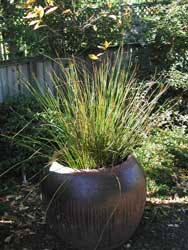Resource Library
Plant of the Week: Rush, Common
The University of Arkansas System Division of Agriculture does not promote, support or recommend plants featured in "Plant of the Week." Please consult your local Extension office for plants suitable for your region.
Plant of the Week
Common Rush
Latin: Juncus effusus

In my garden grows a plant I rescued from a grader ditch during a bit of road construction. It is Juncus effusus, the soft or common rush. Though it has a kind of grassy look it is neither grass nor sedge, which it also resembles. The grasses, sedges and rushes, though found on all continents throughout the world and obviously related, give rise to some basic questions of where they came from and to whom they are related.
Common rush is a clump-forming evergreen perennial, growing up to 3 feet tall with hollow, round, un-branched, leaf-like stems (a culm) that taper from the size of a soda straw at the base to a blunt, bristle-tipped point at the top. This species lacks true leaves. The stems emerge from a compact-growing rhizome that seldom forms clumps more than 18 inches across. Usually the stems are erect-growing, but some may cascade over as they get taller.
Brownish clusters of small, interesting but not showy flowers are produced out the side of the stem a few inches from the top on flowering branches. In actuality, the flowers are produced at the top of the stem, but the extension that looks like the tip of the "leaf" is really a modified bract.
Rushes grow in boggy situations, which they need for seed germination. Typically they are found on the margins of ponds, along sunny streams, in wet pastures or even tidal estuaries. Once established, they will tolerate periodic flooding or even grow in standing water. Most species are considered "weeds," but they are only problematic in pastures because they grow too slowly to be a major concern in cultivated fields. About 300 species of rushes are found throughout the world.
Common rush is found on all continents except Antarctica. How did it achieve this remarkable widespread dispersal? Some of it may have been the result of introduction by man - as is apparently the case in Hawaii - but mostly it is a natural component of the native flora of the various continents.
Two theories explain worldwide dispersal of particular plants. The first is that the species is an old one, and occurred during the epoch when the supercontinent Pangaea existed about 300 million years ago. The second is that the seeds are light and get blown about in the winds, as is believed to be the case with certain ferns that have wide natural distribution ranges.
Traditional classification schemes by observing what a plant physically looks like doesn't help much in resolving this puzzle. A relatively new approach at assessing biological relationships is called cladistics, a system that classifies organisms based on where and when they branched from the tree of life.
The basis for much of this classification is done using DNA analysis and statistical manipulations that leave those of us with math-impaired brains shaking our heads in bemusement. Using their models to predict relationships and relying on the scant record of fossilized pollen, most estimates date the appearance of grass-like plants to the middle Cretaceous about 120 million years ago, during the period when dinosaurs were in their full glory.
These cladistic analyses also indicate that rushes and sedges are more closely related than grasses. Additionally, it seems rushes hold a lower (and hence older) branching position on the tree of life than either the sedges or grasses. So, maybe these odd little plants are really old and date back further than has thus far been proven.
Common rush is used in water and bog gardens or can be used as an evergreen filler for boggy spots or rain gardens, where more finicky plants would perish. Plants require a sunny site to flourish. It tolerates long periods of drought once established, but don't confuse it with true drought-tolerant plants.
Several selections are available, including 'Spiralis' (the Corkscrew Rush), 'Cuckoo' (a variegated form with a yellow stripe) and 'Zebrinus,' with wide white blotches down the length of the "leaf."
By: Gerald Klingaman, retired
Extension Horticulturist - Ornamentals
Extension News - February 19, 2010
The University of Arkansas System Division of Agriculture does not maintain lists of retail outlets where these plants can be purchased. Please check your local nursery or other retail outlets to ask about the availability of these plants for your growing area.